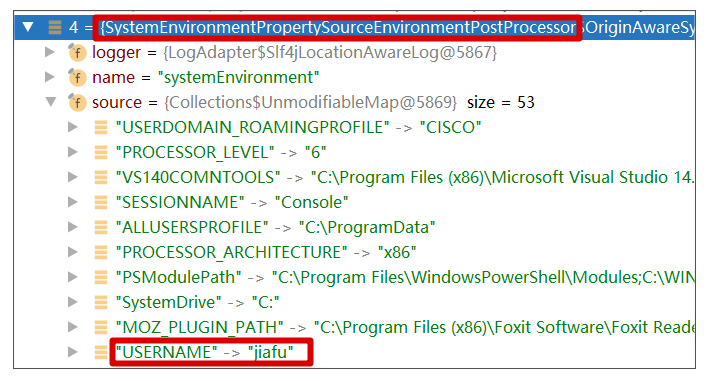03|Spring Bean 依赖注入常见错误(下)
你好,我是傅健,这节课我们接着聊Spring的自动注入。
上一讲我们介绍了3个Spring编程中关于依赖注入的错误案例,这些错误都是比较常见的。如果你仔细分析的话,你会发现它们大多都是围绕着@Autowired、@Qualifier的使用而发生,而且自动注入的类型也都是普通对象类型。
那在实际应用中,我们也会使用@Value等不太常见的注解来完成自动注入,同时也存在注入到集合、数组等复杂类型的场景。这些情况下,我们也会遇到一些问题。所以这一讲我们不妨来梳理下。
案例1:@Value没有注入预期的值
在装配对象成员属性时,我们常常会使用@Autowired来装配。但是,有时候我们也使用@Value进行装配。不过这两种注解使用风格不同,使用@Autowired一般都不会设置属性值,而@Value必须指定一个字符串值,因为其定义做了要求,定义代码如下:
public @interface Value {/*** The actual value expression — for example, <code>#{systemProperties.myProp}</code>.*/String value();}
另外在比较这两者的区别时,我们一般都会因为@Value常用于String类型的装配而误以为@Value不能用于非内置对象的装配,实际上这是一个常见的误区。例如,我们可以使用下面这种方式来Autowired一个属性成员:
@Value("#{student}")private Student student;
其中student这个Bean定义如下:
@Beanpublic Student student(){Student student = createStudent(1, "xie");return student;}
当然,正如前面提及,我们使用@Value更多是用来装配String,而且它支持多种强大的装配方式,典型的方式参考下面的示例:
//注册正常字符串@Value("我是字符串")private String text;//注入系统参数、环境变量或者配置文件中的值@Value("${ip}")private String ip//注入其他Bean属性,其中student为bean的ID,name为其属性@Value("#{student.name}")private String name;
上面我给你简单介绍了@Value的强大功能,以及它和@Autowired的区别。那么在使用@Value时可能会遇到那些错误呢?这里分享一个最为典型的错误,即使用@Value可能会注入一个不是预期的值。
我们可以模拟一个场景,我们在配置文件application.properties配置了这样一个属性:
username=adminpassword=pass
然后我们在一个Bean中,分别定义两个属性来引用它们:
@RestController@Slf4jpublic class ValueTestController {@Value("${username}")private String username;@Value("${password}")private String password;@RequestMapping(path = "user", method = RequestMethod.GET)public String getUser(){return username + ":" + password;};}
当我们去打印上述代码中的username和password时,我们会发现password正确返回了,但是username返回的并不是配置文件中指明的admin,而是运行这段程序的计算机用户名。很明显,使用@Value装配的值没有完全符合我们的预期。
案例解析
通过分析运行结果,我们可以知道@Value的使用方式应该是没有错的,毕竟password这个字段装配上了,但是为什么username没有生效成正确的值?接下来我们就来具体解析下。
我们首先了解下对于@Value,Spring是如何根据@Value来查询“值”的。我们可以先通过方法DefaultListableBeanFactory#doResolveDependency来了解@Value的核心工作流程,代码如下:
@Nullablepublic Object doResolveDependency(DependencyDescriptor descriptor, @Nullable String beanName,@Nullable Set<String> autowiredBeanNames, @Nullable TypeConverter typeConverter) throws BeansException {//省略其他非关键代码Class<?> type = descriptor.getDependencyType();//寻找@ValueObject value = getAutowireCandidateResolver().getSuggestedValue(descriptor);if (value != null) {if (value instanceof String) {//解析Value值String strVal = resolveEmbeddedValue((String) value);BeanDefinition bd = (beanName != null && containsBean(beanName) ?getMergedBeanDefinition(beanName) : null);value = evaluateBeanDefinitionString(strVal, bd);}//转化Value解析的结果到装配的类型TypeConverter converter = (typeConverter != null ? typeConverter : getTypeConverter());try {return converter.convertIfNecessary(value, type, descriptor.getTypeDescriptor());}catch (UnsupportedOperationException ex) {//异常处理}}//省略其他非关键代码}
可以看到,@Value的工作大体分为以下三个核心步骤。
1. 寻找@Value
在这步中,主要是判断这个属性字段是否标记为@Value,依据的方法参考QualifierAnnotationAutowireCandidateResolver#findValue:
@Nullableprotected Object findValue(Annotation[] annotationsToSearch) {if (annotationsToSearch.length > 0) {AnnotationAttributes attr = AnnotatedElementUtils.getMergedAnnotationAttributes(AnnotatedElementUtils.forAnnotations(annotationsToSearch), this.valueAnnotationType);//valueAnnotationType即为@Valueif (attr != null) {return extractValue(attr);}}return null;}
2. 解析@Value的字符串值
如果一个字段标记了@Value,则可以拿到对应的字符串值,然后就可以根据字符串值去做解析,最终解析的结果可能是一个字符串,也可能是一个对象,这取决于字符串怎么写。
3. 将解析结果转化为要装配的对象的类型
当拿到第二步生成的结果后,我们会发现可能和我们要装配的类型不匹配。假设我们定义的是UUID,而我们获取的结果是一个字符串,那么这个时候就会根据目标类型来寻找转化器执行转化,字符串到UUID的转化实际上发生在UUIDEditor中:
public class UUIDEditor extends PropertyEditorSupport {@Overridepublic void setAsText(String text) throws IllegalArgumentException {if (StringUtils.hasText(text)) {//转化操作setValue(UUID.fromString(text.trim()));}else {setValue(null);}}//省略其他非关代码}
通过对上面几个关键步骤的解析,我们大体了解了@Value的工作流程。结合我们的案例,很明显问题应该发生在第二步,即解析Value指定字符串过程,执行过程参考下面的关键代码行:
String strVal = resolveEmbeddedValue((String) value);
这里其实是在解析嵌入的值,实际上就是“替换占位符”工作。具体而言,它采用的是PropertySourcesPlaceholderConfigurer根据PropertySources来替换。不过当使用 ${username} 来获取替换值时,其最终执行的查找并不是局限在application.property文件中的。通过调试,我们可以看到下面的这些“源”都是替换依据:

[ConfigurationPropertySourcesPropertySource {name='configurationProperties'},StubPropertySource {name='servletConfigInitParams'}, ServletContextPropertySource {name='servletContextInitParams'}, PropertiesPropertySource {name='systemProperties'}, OriginAwareSystemEnvironmentPropertySource {name='systemEnvironment'}, RandomValuePropertySource {name='random'},OriginTrackedMapPropertySource {name='applicationConfig: classpath:/application.properties]'},MapPropertySource {name='devtools'}]
而具体的查找执行,我们可以通过下面的代码(PropertySourcesPropertyResolver#getProperty)来获取它的执行方式:
@Nullableprotected <T> T getProperty(String key, Class<T> targetValueType, boolean resolveNestedPlaceholders) {if (this.propertySources != null) {for (PropertySource<?> propertySource : this.propertySources) {Object value = propertySource.getProperty(key);if (value != null) {//查到value即退出return convertValueIfNecessary(value, targetValueType);}}}return null;}
从这可以看出,在解析Value字符串时,其实是有顺序的(查找的源是存在CopyOnWriteArrayList中,在启动时就被有序固定下来),一个一个“源”执行查找,在其中一个源找到后,就可以直接返回了。
如果我们查看systemEnvironment这个源,会发现刚好有一个username和我们是重合的,且值不是pass。

所以,讲到这里,你应该知道问题所在了吧?这是一个误打误撞的例子,刚好系统环境变量(systemEnvironment)中含有同名的配置。实际上,对于系统参数(systemProperties)也是一样的,这些参数或者变量都有很多,如果我们没有意识到它的存在,起了一个同名的字符串作为@Value的值,则很容易引发这类问题。
问题修正
针对这个案例,有了源码的剖析,我们就可以很快地找到解决方案了。例如我们可以避免使用同一个名称,具体修改如下:
user.name=adminuser.password=pass
但是如果我们这么改的话,其实还是不行的。实际上,通过之前的调试方法,我们可以找到类似的原因,在systemProperties这个PropertiesPropertySource源中刚好存在user.name,真是无巧不成书。所以命名时,我们一定要注意不仅要避免和环境变量冲突,也要注意避免和系统变量等其他变量冲突,这样才能从根本上解决这个问题。
通过这个案例,我们可以知道:Spring给我们提供了很多好用的功能,但是这些功能交织到一起后,就有可能让我们误入一些坑,只有了解它的运行方式,我们才能迅速定位问题、解决问题。
案例2:错乱的注入集合
前面我们介绍了很多自动注入的错误案例,但是这些案例都局限在单个类型的注入,对于集合类型的注入并无提及。实际上,集合类型的自动注入是Spring提供的另外一个强大功能。
假设我们存在这样一个需求:存在多个学生Bean,我们需要找出来,并存储到一个List里面去。多个学生Bean的定义如下:
@Beanpublic Student student1(){return createStudent(1, "xie");}@Beanpublic Student student2(){return createStudent(2, "fang");}private Student createStudent(int id, String name) {Student student = new Student();student.setId(id);student.setName(name);return student;}
有了集合类型的自动注入后,我们就可以把零散的学生Bean收集起来了,代码示例如下:
@RestController@Slf4jpublic class StudentController {private List<Student> students;public StudentController(List<Student> students){this.students = students;}@RequestMapping(path = "students", method = RequestMethod.GET)public String listStudents(){return students.toString();};}
通过上述代码,我们就可以完成集合类型的注入工作,输出结果如下:
[Student(id=1, name=xie), Student(id=2, name=fang)]
然而,业务总是复杂的,需求也是一直变动的。当我们持续增加一些student时,可能就不喜欢用这种方式来注入集合类型了,而是倾向于用下面的方式去完成注入工作:
@Beanpublic List<Student> students(){Student student3 = createStudent(3, "liu");Student student4 = createStudent(4, "fu");return Arrays.asList(student3, student4);}
为了好记,这里我们不妨将上面这种方式命名为“直接装配方式”,而将之前的那种命名为“收集方式”。
实际上,如果这两种方式是非此即彼的存在,自然没有任何问题,都能玩转。但是如果我们不小心让这2种方式同时存在了,结果会怎样?
这时候很多人都会觉得Spring很强大,肯定会合并上面的结果,或者认为肯定是以直接装配结果为准。然而,当我们运行起程序,就会发现后面的注入方式根本没有生效。即依然返回的是前面定义的2个学生。为什么会出现这样的错误呢?
案例解析
要了解这个错误的根本原因,你就得先清楚这两种注入风格在Spring中是如何实现的。对于收集装配风格,Spring使用的是DefaultListableBeanFactory#resolveMultipleBeans来完成装配工作,针对本案例关键的核心代码如下:
private Object resolveMultipleBeans(DependencyDescriptor descriptor, @Nullable String beanName,@Nullable Set<String> autowiredBeanNames, @Nullable TypeConverter typeConverter) {final Class<?> type = descriptor.getDependencyType();if (descriptor instanceof StreamDependencyDescriptor) {//装配streamreturn stream;}else if (type.isArray()) {//装配数组return result;}else if (Collection.class.isAssignableFrom(type) && type.isInterface()) {//装配集合//获取集合的元素类型Class<?> elementType = descriptor.getResolvableType().asCollection().resolveGeneric();if (elementType == null) {return null;}//根据元素类型查找所有的beanMap<String, Object> matchingBeans = findAutowireCandidates(beanName, elementType,new MultiElementDescriptor(descriptor));if (matchingBeans.isEmpty()) {return null;}if (autowiredBeanNames != null) {autowiredBeanNames.addAll(matchingBeans.keySet());}//转化查到的所有bean放置到集合并返回TypeConverter converter = (typeConverter != null ? typeConverter : getTypeConverter());Object result = converter.convertIfNecessary(matchingBeans.values(), type);//省略非关键代码return result;}else if (Map.class == type) {//解析mapreturn matchingBeans;}else {return null;}}
到这,我们就不难概括出这种收集式集合装配方式的大体过程了。
1. 获取集合类型的元素类型
针对本案例,目标类型定义为List<Student> students,所以元素类型为Student,获取的具体方法参考代码行:
Class<?> elementType = descriptor.getResolvableType().asCollection().resolveGeneric();
2. 根据元素类型,找出所有的Bean
有了上面的元素类型,即可根据元素类型来找出所有的Bean,关键代码行如下:
Map<String, Object> matchingBeans = findAutowireCandidates(beanName, elementType, new MultiElementDescriptor(descriptor));
3. 将匹配的所有的Bean按目标类型进行转化
经过步骤2,我们获取的所有的Bean都是以java.util.LinkedHashMap.LinkedValues形式存储的,和我们的目标类型大概率不同,所以最后一步需要做的是按需转化。在本案例中,我们就需要把它转化为List,转化的关键代码如下:
Object result = converter.convertIfNecessary(matchingBeans.values(), type);
如果我们继续深究执行细节,就可以知道最终是转化器CollectionToCollectionConverter来完成这个转化过程。
学习完收集方式的装配原理,我们再来看下直接装配方式的执行过程,实际上这步在前面的课程中我们就提到过(即DefaultListableBeanFactory#findAutowireCandidates方法执行),具体的执行过程这里就不多说了。
知道了执行过程,接下来无非就是根据目标类型直接寻找匹配的Bean。在本案例中,就是将Bean名称为students的List<Student>装配给StudentController#students属性。
了解了这两种方式,我们再来思考这两种方式的关系:当同时满足这两种装配方式时,Spring是如何处理的?这里我们可以参考方法DefaultListableBeanFactory#doResolveDependency的几行关键代码,代码如下:
Object multipleBeans = resolveMultipleBeans(descriptor, beanName, autowiredBeanNames, typeConverter);if (multipleBeans != null) {return multipleBeans;}Map<String, Object> matchingBeans = findAutowireCandidates(beanName, type, descriptor);
很明显,这两种装配集合的方式是不能同存的,结合本案例,当使用收集装配方式来装配时,能找到任何一个对应的Bean,则返回,如果一个都没有找到,才会采用直接装配的方式。说到这里,你大概能理解为什么后期以List方式直接添加的Student Bean都不生效了吧。
问题修正
现在如何纠正这个问题就变得简单多了,就是你一定要下意识地避免这2种方式共存去装配集合,只用一个这个问题就迎刃而解了。例如,在这里,我们可以使用直接装配的方式去修正问题,代码如下:
@Beanpublic List<Student> students(){Student student1 = createStudent(1, "xie");Student student2 = createStudent(2, "fang");Student student3 = createStudent(3, "liu");Student student4 = createStudent(4, "fu");return Arrays.asList(student1,student2,student3, student4);}
也可以使用收集方式来修正问题时,代码如下:
@Beanpublic Student student1(){return createStudent(1, "xie");}@Beanpublic Student student2(){return createStudent(2, "fang");}@Beanpublic Student student3(){return createStudent(3, "liu");}@Beanpublic Student student4(){return createStudent(4, "fu");}
总之,都是可以的。还有一点要注意:在对于同一个集合对象的注入上,混合多种注入方式是不可取的,这样除了错乱,别无所得。
重点回顾
今天我们又学习了关于Spring自动注入的两个典型案例。
通过案例1的学习,我们了解到@Value不仅可以用来注入String类型,也可以注入自定义对象类型。同时在注入String时,你一定要意识到它不仅仅可以用来引用配置文件里配置的值,也可能引用到环境变量、系统参数等。
而通过案例2的学习,我们了解到集合类型的注入支持两种常见的方式,即上文中我们命名的收集装配式和直接装配式。这两种方式共同装配一个属性时,后者就会失效。
综合上一讲的内容,我们一共分析了5个问题以及背后的原理,通过这些案例的分析,我们不难看出Spring的自动注入非常强大,围绕@Autowired、@Qualifier、@Value等内置注解,我们可以完成不同的注入目标和需求。不过这种强大,正如我在开篇词中提及的,它建立在很多隐性的规则之上。只有你把这些规则都烂熟于心了,才能很好地去规避问题。
思考题
在案例2中,我们初次运行程序获取的结果如下:
[Student(id=1, name=xie), Student(id=2, name=fang)]
那么如何做到让学生2优先输出呢?
我们留言区见!